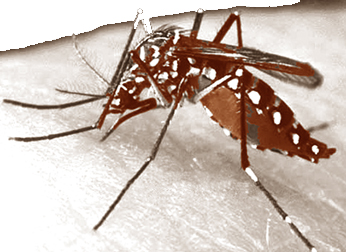Dengue - A paradox of prevention and case management
by Prof. Kolitha H Sellahewa
Dengue was known to mankind for over 200 years and was not considered
to be a major public health concern for several decades. A resurgence of
interest in this age old disease arose only after it ravaged mankind
with several epidemics.
The first pandemic was in 1998. Sri Lanka experienced her first
epidemic in 1989 with an exponential increase in incidence ever since
with an average of 35,000 cases per year. Sri Lanka currently holds the
ignoble tag of a hyper-endemic country in the South-East Asian region
according to the World Health Organisation with an incidence of
175/100,000 population.
Experts in public health and the Ministry of Health (MOH)with support
from the public, otherstate and private sector organizationshad
relentlessly pursed its efforts to curb the disease incidence. Dengue is
caused by an arbovirus of which there are 4 serotypes.
The vector transmitting the disease is a mosquito of the species
Aedesaegypti and A. albopictus.
 Preventive
methods have primarily addressed the elimination of adult mosquitoes and
its breeding sites. Unplanned town development, urbanisation of an
unprecedented scale, and improper waste disposal owing to callousness
and lack of civic consciousness of the public, compounded by less than
optimal government mechanisms for solid waste management are some of the
main reasons I could conceptualise for this predicament. Preventive
methods have primarily addressed the elimination of adult mosquitoes and
its breeding sites. Unplanned town development, urbanisation of an
unprecedented scale, and improper waste disposal owing to callousness
and lack of civic consciousness of the public, compounded by less than
optimal government mechanisms for solid waste management are some of the
main reasons I could conceptualise for this predicament.
While conceding the importance of prevention we need to reconcile
that prevention has not been successful even in clean rich countries
like Singapore where the incidence of dengue has increased despite a
reduction in the mosquito burden.
Morbidity and mortality
It is against such a background that clinicians like me resorted to
develop methods to reduce morbidity and mortality among dengue infected
patients by improving case management. Dengue infection results in two
fundamentally different clinical types’ viz. dengue fever (DF) and
dengue haemorrhagic fever (DHF). DF typically takes an uneventful benign
course towards complete recovery. DHF on the other hand has the
propensity to develop severe disease with attended increased morbidity
and death. Fortunately however DHF has a highly stereotyped predictable
course which gives the clinician a window of opportunity for rational
and timely appropriate interventions to manipulate the disease course
and ensure a shift towards a favourable outcome.
In DHF there is a critical phase setting in between the 3rd to 7th
day of the illness (the day on which the fever started is counted as day
1) and typically lasts only 24 – 48 hours. The pathological hall mark in
this phase of the illness is plasma leakage with attended intravascular
volume depletion that can lead to all the serious complications such as
bleeding, kidney failure, liver failure and death.
Judicious fluid therapy in the face of plasma leakage can conceivably
offset an adverse outcome resulting from intravascular volume depletion.
Early detection of plasma leakage and proper management over the
critical 48 hour period can ensure a smooth transition to convalescence
and complete recovery.
Astute clinicians with a clear understanding of these fundamental
principles have contributed to the success story of dengue. The paradox
of success is the reduction in case fatality from 5% in 1996 to 1% in
2009 and the lowest 0.2% recorded in 2014 despite an increased incidence
of 47,502 cases in 2014 and also an increase in the proportion of DHF,
the more severe form of the disease to 10-15%.
Case management
The road to this success was never an easy one. My first attempts to
improve case management started as far back as 1990. I resolved to
manage dengue patients by applying simple physiological principles in
fluid therapy and also avoiding platelet transfusions despite drops in
the platelet count and often digressing from accepted WHO guidelines on
fluid therapy in that era. This approach was controversial and was not
accepted and opposed by the medical fraternity at large when presented
in academic fora. Nevertheless I resorted to do what I thought
wasintrinsically right resigning to change only the microenvironment in
which I worked. The success story was then only an individual one with
only one death among > 3,000 patients treated under my care up to 2008.
The only death was in 1997. This was a patient who came late in the
disease course with massive bleeding and died within 2 hours of
admission to the state hospital where I was then working.
It is only after I retired from the department of health services
that I got the best opportunity to impact case management at a national
level. Shaken by the biggest dengue epidemic Sri Lanka experienced in
2009 with 35,010 cases and 346 deaths dengue assumed a place of grave
concern in the political arena.
The epidemiology unitheaded by the chief epidemiologist Dr Paba
Palihawadana along with dengue prevention unit of the MOH which was
doing a tremendous job related to dengue till then received the
ministerial backing to escalate their work. Towards this end they
employed Dr Jayantha Weeraman (a consultant paediatrician) and me in
2010 to provide expert technical assistance to improve case management
of severe paediatric and adult dengue cases.
We were also assigned the sensitive and arduous task of conducting an
in-depth clinical/death audit of dengue case management in Sri Lanka.
We filled the void of clinical expertise in the epidemiology unit and
the two of us utilised our profound clinical experience to give inputs
to develop a collective strategy with other clinicians to reduce dengue
related deaths.
(The writer is Professor of Medicine, South Asian
Institute of Technology & Medicine, Dr Neville Fernando Teaching
Hospital, Malabe) |

